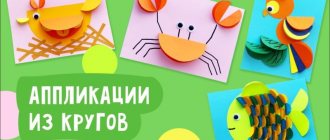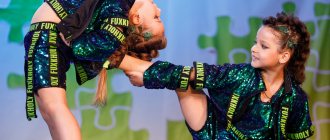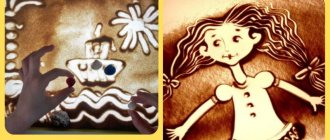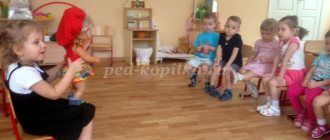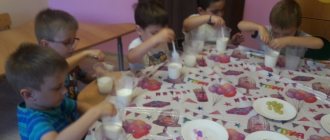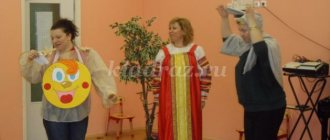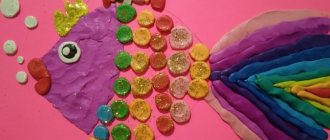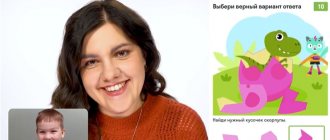The work program of the circle at the preschool educational institution “Russian Checkers” in the preparatory group
| January | Solving simple problems on the board | 4 |
| February | Training tournaments | 4 |
| March | Tournament for a kindergarten prize | 1 |
| City checkers tournament | 1 | |
| April | Games with children 5 – 6 years old | 4 |
| May | Checkers tournament with parents | 2 |
| Total | 32 |
One year of training involves one lesson per week lasting 20-30 minutes. The number in the circle is 14, the age of children is 6 – 7 years.
Program content
At the first stage, the teacher conducts a conversation with the children. He offers boards for examination, children highlight black and white fields, distributes checkers into each child’s hands, offers to examine the chips from the inside, to make sure of the features of the appearance of the inverted checker (the future of the queen).
At the next stage, the teacher gives the students two chips of different colors and explains that the checkers on the field (regardless of their color) stand and move only on black cells. The teacher invites the children to independently place their chips anywhere on the board, while ensuring that they are correctly placed on the black squares. After the children looked at the checkers, they held them in their hands. The teacher gives the children the task of placing the checkers correctly on the playing field. He explains to preschoolers that before the game starts, chips of different colors are on their halves of the playing field. At the same time, it remains free so that you can make a move. Checkers should be placed in three rows from the edge of the playing field closest to you and only on black cells. To consolidate the information received, children are given 12 checkers of the same color with the task of placing them on the field.
Next, learning moves diagonally forward to a free adjacent black field occurs. The number of checkers is reduced from 12(24) to 4(8).
When preschoolers get an idea of where the checkers are on the field and how they move, the meaning of the game should be explained to them. The task is to destroy the opponent's checkers while moving your own checkers forward. A simple checker does not move backwards. The loser is the one who has no checkers left on the playing field or is unable to make moves.
The training game is played with a limited number of checkers on the field. While practicing their moves, children will be faced with a situation where the opponents' checkers meet on adjacent fields diagonally, and the field behind the opponent's checker is free. The teacher shows that the player whose turn it is to make a move must take (hit) the opponent’s checker and remove it from the field. A simple checker can hit an opponent's checker by moving backwards.
At the next stage, you can tell the children. That in any battle, including checkers, there are heroes. These are simple checkers, which, having reached the last row of the opponent’s field, become shock checkers - kings - and continue the battle. The queen can move along all diagonals of the playing field, destroying the opponent's checkers. It is an inverted chip.
Annual plan for a board games club. “Miracle of Checkers”, “Tyryynka” Senior preparatory group. on the city
Transcript
1 Municipal budgetary preschool educational institution General developmental kindergarten “Sun”. Approved From 2022 Head: Nikitina S.P. Annual plan for the circle board games “Miracle Checkers”, “Tyryynka” Senior preparatory group. on the city. Head: Cherkashina G.N. There are 5 children in school.
2 Work plan for the circle “Miracle Checkers”, “Tyryynka” Explanatory note. “Miracle Checkers” The types of games for children are very diverse. In kindergarten, games are used that are designed specifically to develop children's mental abilities, improve and train their memory and thinking. One such game is the game “Checkers”. Checkers is an exciting game that develops perseverance and the ability to concentrate, and trains mental flexibility. The rules of the game are simple, as long as you don't turn it into a boring game. Getting to know the unique world of checkers will help prepare the child’s mind to perceive abstract logical categories. Enthused by the “battle,” a child in the “Land of Checkers” will be able to force himself to sit still and try to focus his attention on the events taking place on the board. A cognitive-speech club with the integration of educational areas: cognitive development, speech development, physical education, artistic and aesthetic development, social and communicative development, for children aged 5-6 years. Board game of the Sakha people “Tyryynka” - board games reflect the traditions, lifestyle, and way of life of the Sakha people. - they develop flexibility of fingers and hands, dexterity, coordination, resourcefulness and mental abilities. -they contribute to the transfer of vital skills, education of morality, respect for folk traditions and customs. - advantage: both children and adults play, the material and production of equipment is accessible to everyone, environmentally friendly. — folk board games are the best way for children and parents to spend their leisure time together. Goal: Teaching preschoolers the principles of the game, instilling in them an interest and love for these games, preparing students for further stages of development. Get children interested and interested in board games. Objectives: Educational: - teach the basics of board games; — teach simple combinations, theory and practice of the game.
3 Educational: - to cultivate an attitude towards games as serious, useful and necessary activities that have a sporting and creative orientation; — to cultivate: perseverance, determination, resourcefulness, attentiveness, self-confidence and the ability to overcome difficulties; - develop in children the ability to apply acquired knowledge in practice. — fostering respect and love for Yakut board games; Developmental: - develop children’s desire for independence; - develop the mental abilities of children: logical thinking, the ability to make calculations several moves ahead, development of fine motor skills. Physical: - carry out the comprehensive physical development of children. The main forms of work and means of teaching are: - practical games; - solving problems, combinations; — didactic games and tasks, game exercises; - entertainment, educational leisure, games of checkers and Tyryynka. Expected results: - play board games "checkers", "Tyryynka" - the rules of the move, navigate on the checkers board - solve simple checkers problems - knowledge of the basics of board games - perform technical techniques of the game "Tyryynka" Organizational and methodological instructions for conducting club classes " Miracle of Checkers", "Tyryynka". — Classes are held once a week, in the afternoon, for a minute at a time, and consist of three parts: introductory, main, final. — Classes on the Yakut folk game “Tyryynka” are held at the end of each month. — Before educational activities, a sedentary game is played.
4 - Activities in the game gradually become more difficult. Handouts: checkers boards and sets of checkers, sticks for the game Tyryynka Involve a circle of parents in the work to make attributes. Work with parents: Introduce parents to the circle program. Conduct a survey of parents on the topic “Playing checkers with children.” Update checker boards and sets of checkers, sticks for the game "Tyryynka" Help for parents in making checker boards, pieces for the game (together with children), sticks. List of students: 1. Pudov Albert Struchkov Arthur Sosin Pasha Pavlova Regina. 5. Cherkashina Veronica. Long-term planning of the work of the “Miracle Checkers” circle “Tyryynka”. Goal: to teach children how to handle a chessboard, pieces, to teach games of “Checkers”, “Corners”, “Giveaway”, to teach children to use terms when playing; cultivate perseverance, curiosity, the ability to win and be defeated, develop logical thinking, fine motor skills, movement coordination, ingenuity, and dexterity. September Introduction to Horizontal. chessboard. Introduction to the game of the Sakha peoples “Tyryynka”. Preparing a play area for children. Goal: to teach children how to handle the chessboard and pieces. Goal: To teach how to fill one of the horizontal lines of a chessboard Goal: To teach children the rules of handling sticks. Goal: creating conditions. Learning finger gymnastics with
5 boards with cubes (chips). using sticks to play. October "Vertical". “Diagonal”. Definition Teach children long and short independently and from diagonals. pleasure to play. Goal: To teach how to fill one of the vertical lines of the chessboard with cubes (chips). Goal: development of abilities. Learning moves during the game. November Introduction to checkers pieces. Initial arrangement of pieces Learning to play. Moves and capture of pieces. Explanation of the position in the game. Game with rivals. Goal: To encourage the ability to independently place pieces in the starting position, determine the direction of moves.. Goal: To introduce the rules of moving and capturing pieces. Goal: continue to teach how to play the game “Tyryynka”. Goal: to cultivate perseverance, curiosity, the ability to win and be defeated, develop logical thinking, fine motor skills. December Tasks and tasks developing logical thinking. rivals. rivals. Checkers competitions and “Tyryynka” for a sweet prize.
6 Goal: developing the ability to reason logically, generalize your knowledge... Goal: provide the opportunity to choose a game according to your wishes. January Introduction to the game of giveaway. Continued acquaintance with the games of the peoples of Sakha. children and adults (educators). Goal: teach games of “Giveaway” Goal: development of abilities. February Who lost, won. rivals to rivals. Game with rivals. "Checkers" and "Giveaways". Goal: Continue to practice the rules of giving, the desire to overcome difficulties, and self-confidence. Goal: to consolidate the skills of playing “Checkers” and “Giveaway”. Goal: to cultivate perseverance, curiosity, the ability to win and be defeated, develop logical thinking, fine motor skills. March Educational games. Demonstration and training of the game “Corners”. Goal: Continuation and training of Yakut games. rivals
7 formation of the ability to reason logically and generalize one’s knowledge. Goal: introduction to a new game, development of abilities in children. Goal: introduction to the new game “Habylyk” - sticks, development of abilities in children. April Competition game "Giveaway" 1st round Competition game "Corners" 2nd round with rivals. Goal: to cultivate perseverance, curiosity, the ability to win and be defeated, develop logical thinking, fine motor skills. rivals Goal: develop children's abilities, cultivate perseverance and curiosity May Checkers competition 1st round Goal: teach children to use terms when playing, cultivate perseverance Competition in the board game "Tyryynka" 1st round Game "Tyryynka" with parents. Goal: developing communication skills, the desire to overcome difficulties, and self-confidence.
8 Yakut board game “Tyryynka” for children of the senior group Relevance: - board games reflect the traditions, lifestyle, and way of life of the Sakha people. - they develop flexibility of fingers and hands, dexterity, coordination, resourcefulness and mental abilities. -they contribute to the transfer of vital skills, education of morality, respect for folk traditions and customs. - advantage: both children and adults play, the material and production of equipment is accessible to everyone, environmentally friendly. — folk board games are the best way for children and parents to spend their leisure time together. 1. Topic: Yakut board game Tyryynka (pulling out splinters one at a time). Goal: 1. To introduce children to the Yakut board game Tyryynka Objectives: 1. To teach children to play independently and with pleasure. 2. Develop attention, thinking and dexterity in children. 3. Attract and interest children and parents in the board game Tyryynka. — Main stage: 1. Introduction to the rules of the Tyryynka game 2. Learning finger gymnastics using playing sticks. 3. Come up with and put together a game - making up figures using sticks for the game Tyryynka 4. Life safety rules for handling sticks. 5. Round table for parents Tyryynka Sakha trt oonnyuulara 6. Making attributes for the game Tyryynka 7. Competition between children.
9 Expected result: - As a result of the work, the knowledge and interest of children and parents in the Kyakut board game Tyryynka will expand. — Children will master the technique of playing Tyryynka — For each child, parents will make a set of sticks for the game. Literature: “Adventures on the checkers board” -L.; Leninzdat, 1969, “Learning to play checkers” - Vasilevsky R.G. Kyiv: Health, 1985, “Book about checkers” - Gorodetsky B.G. M.: Physical education and sports, “Checkers is interesting” - Gertsenzon B., Napreenkov A. St. Petersburg; Litera, 1992 Dvorsportinfo.ru, ynqa.ucoz.ru - Tyryynka.
